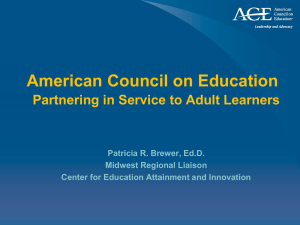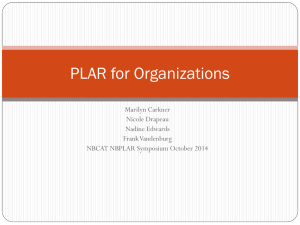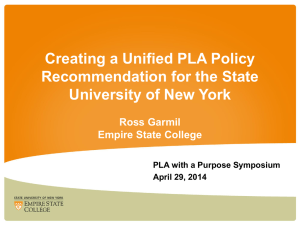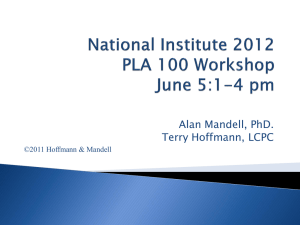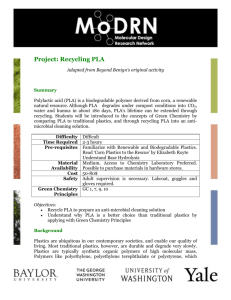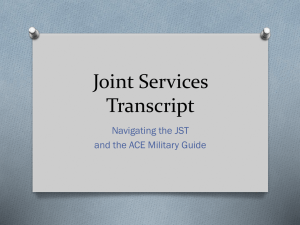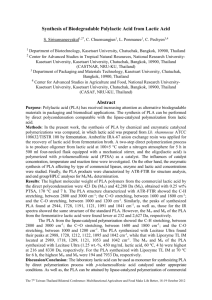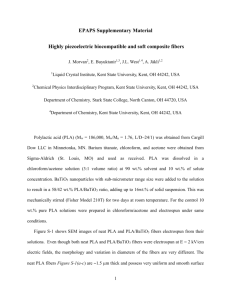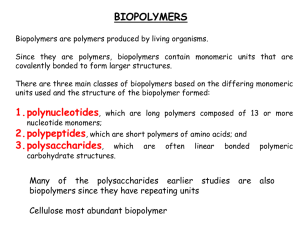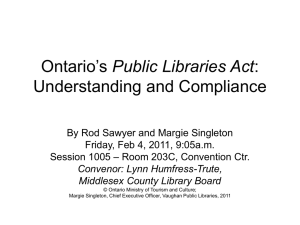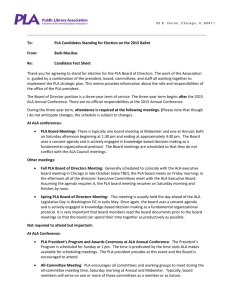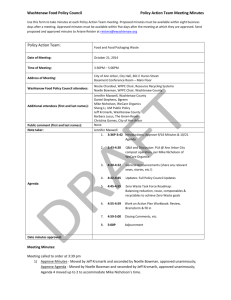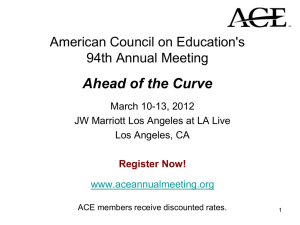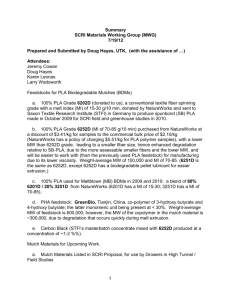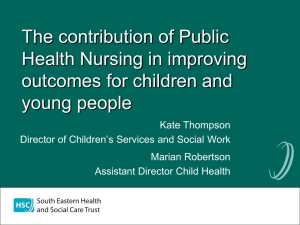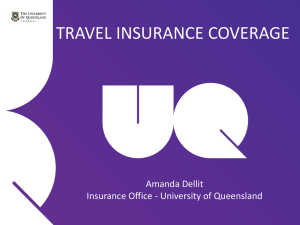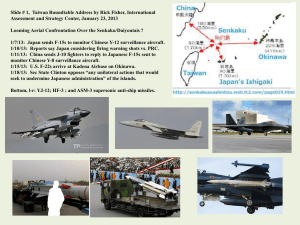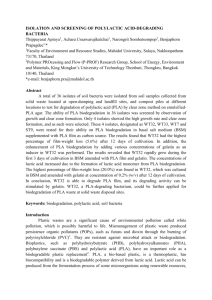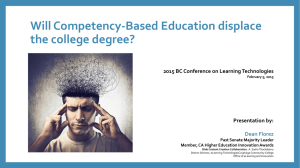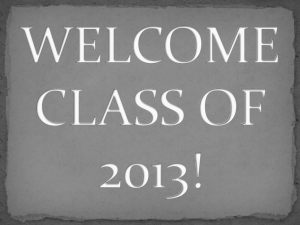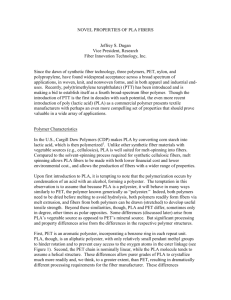Prior Learning Assessment: Take Their
advertisement
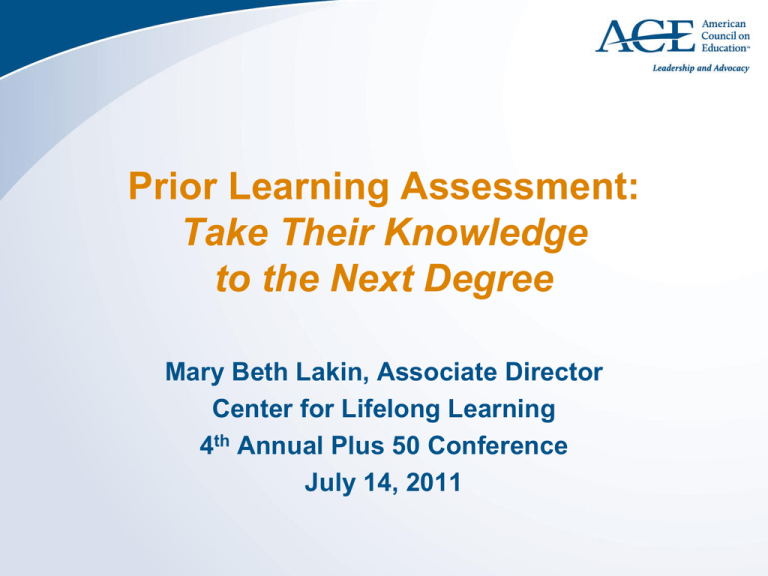
Prior Learning Assessment: Take Their Knowledge to the Next Degree Mary Beth Lakin, Associate Director Center for Lifelong Learning 4th Annual Plus 50 Conference July 14, 2011 Session Agenda • What is ACE? • What is prior learning assessment (PLA)? • What does the research tell us? • How are higher ed institutions applying PLA? Discussion Thread Does your college apply any of the prior learning assessment methods? How could you incorporate prior learning assessment in your Plus 50 program? How might prior learning assessment attract, retain, and benefit your program participants? ACE: Overview Founded in 1918, the American Council on Education (ACE), is the major coordinating body for all the nation's higher education institutions, representing more than 1,600 college and university presidents, and more than 200 related associations, nationwide. It provides leadership on key higher education issues and influences public policy through advocacy. 4 What is Prior Learning Assessment? WHAT an individual learns is more important than when, where, and how the individual learned it. Prior Learning Prior learning is learning gained outside the college classroom. Prior learning occurs in a variety of settings and through different means, from independent study and community service to workforce and military training and experience. Prior learning may be equivalent to college-level skills and knowledge and warrant academic credit. Prior Learning Assessment Many colleges evaluate for academic credit the college-level knowledge and skills an individual has gained outside of the classroom, including employment, military training/service, travel, hobbies, civic activities and volunteer service. PLA awards credit for learning, not credit for experience. 8 Multiple Assessment Methods • Formal evaluation of workplace training • Formal evaluation of military occupations and training • Nationally recognized certifications developed to meet industry/professional standards • Challenge exams offered by colleges • Portfolio development to demonstrate course knowledge or competencies • Blended assessment methods ACE Center for Lifelong Learning • Program Evaluations – Military Programs – Corporate Programs (ACE CREDIT) • Program Evaluation Activities – Evaluate formal courses and occupational specialties – Publish course and occupation descriptions and academic credit recommendations – Provide transcript and registry services ACE’s Military Evaluation Program • MEP provides institutions with basis for recognizing military educational experiences in terms of civilian academic credit. • Since the early 1940s, MEP has reviewed & made credit recommendations for thousands of college-level courses offered by the military services. • In 1974 MEP began evaluation of military occupational specialties. Military Guide Online Example of Military Transcript: SMART ACE College Credit Recommendation Service (ACE CREDIT) began in mid-1970s. Review process for participating organizations uses standards and procedures established through Military Evaluation Program. Corporations Government Federal Bureau of Prisons Immigration and Naturalization Service U.S. Marshals Service Foreign Service Institute www.acenet.edu/nationalguide ACE Transcript Services ACE CREDIT Registry and Transcript System http://www.acenet.edu/transcripts What Does the Research Tell Us? Application of PLA can. . . Increase number of credentials earned Broaden pathways to credentials Accelerate time to completion Reach out to underserved populations Decrease cost Inspire the Reluctant Opportunity to earn credit for prior learning is 1 of top motivators for adults with some college but no degree. The demand is there 2010 study of 88 community colleges: 46% indicated greater use of PLA at their institution if they could evaluate technical training & map to courses. 72% said they thought there would be increased demand for PLA options in the future. http://www.cael.org/pdf/PLA_CommunityColleges.pdf So are the challenges • • • • • • • Institutional Buy-in Allocation of Time & Resources Professional Development Templates for Policy & Practice Articulation & Transfer Financing Assessment: Learners & Evaluators Learner Expectations Fueling the Race To Postsecondary Success 2010 report of 48-institution study of PLA & outcomes for 62,475 learners age 25 & older Increased graduation rates, greater persistence, & shorter time to degree regardless of institutional type & size http://www.cael.org/pdf/PLA_Fueling-the-Race.pdf Policy and Practice Matter • College-level knowledge & competencies can be demonstrated and validated through multiple options. • Adults bring range of learning experiences and require range of methods. • With more options comes increased likelihood for greater numbers of learners to complete credentials. • More flexibility translates to better academic outcomes. Employer Perspectives • Corporate Voices for Working Families: Promotes PLA & educational partnerships as leading edge practices • Department of Defense: Identified millions of dollars in tuition savings with application of ACE credit • Delta Study: Found company & employees saved dollars & time to degree How are Higher Ed Institutions applying PLA? At the institutional level • Ivy Tech Community College: Certification Crosswalk http://www.ivytech.edu/priorlearning/CertcrosswalkDecember2010.pdf • Excelsior College: Degree Maps for McDonald’s training programs http://www.excelsior.edu/corporate-partners/mcdonalds/degreemaps • Coastline Community College: A.S., Health Care Management https://www.goarmyed.com/docs/degrees/CCC_AA-HST.pdf At the state level • NJ PLACE at Rutgers University: Pathways Leading Apprentices to a College Education http://www.njplace.com/ • Minnesota Colleges and Universities: System Wide Policies for PLA Options http://www.inverhills.edu/ProgramsAndMajors/ASAP/PLA.aspx https://www.metrostate.edu/msweb/explore/cls/priors/steps.html • Wisconsin Prior Learning Assessment Expansion: http://www.adultcollegecompletion.org/content/wisconsin-prior-learningassessment-expansion At the national level • Maps to Credentials: Creating an Integrated Prior Learning Assessment Model • Virtual Career Network (VCN): Providing PLA tools & resources in healthcare • Troops to Energy Jobs: Center for Energy Workforce Development • Learning Counts: Virtual PLA Service http://www.learningcounts.org Mapping PLA Credits to Credentials • Guide learner to degree completion. • Chart prior learning credits to specific courses. • Include all aspects of degree requirements. • Provide assessment options for new learning. • Adapt for programs & populations. Example: Minnesota State Colleges & Universities System Veterans’ Course Mappings: http://www.students.mnscu.edu/military/vets/identifyMilitaryExp.php Degree Mapping Initiative Mapping PLA Credits to Credentials ACE CREDIT College & University Network • Recognition of ACE Credit Recommendations • Advocacy & Articulation • Development of Employer Partnerships • Creation of Maps to Credentials • Website Profiles http://www.acenet.edu/credit/network The maps they gave us were out of date by years. --Adrienne Rich Questions for Plus50 Learners: Take Their Prior Learning To the Next Degree • Are you a military veteran? Have you requested a copy of your military transcript? • Have you completed formal workplace training? • Do you have any professional certifications? • Have you successfully completed national examinations such as CLEP or DANTES? • Do you have other work or community experiences that might translate to college-level credit? Discussion Thread Does your college apply any of the prior learning assessment methods? How could you incorporate prior learning assessment in your Plus 50 program? How might prior learning assessment attract, retain, and benefit your program participants? Questions? Contact: Mary Beth Lakin mlakin@acenet.edu 202.939.9704

